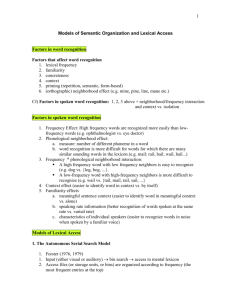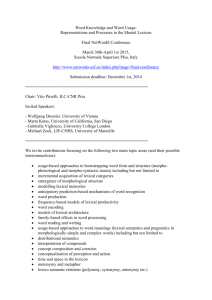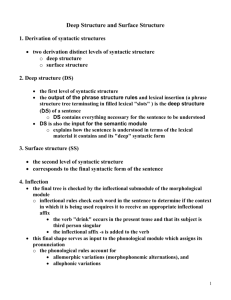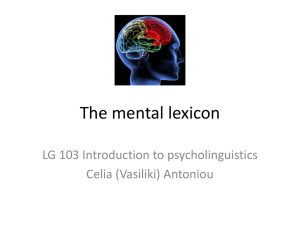Psycholinguistics 05
advertisement
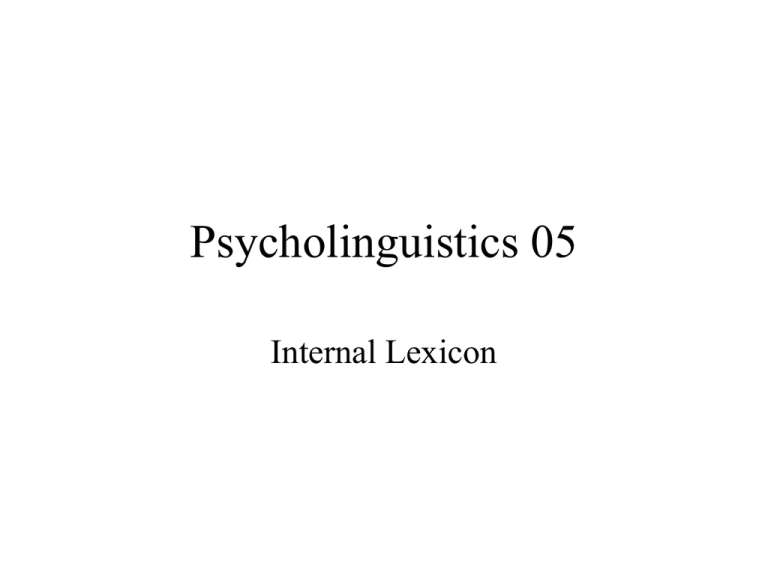
Psycholinguistics 05 Internal Lexicon The Internal Lexicon • Internal lexicon: representation of words in permanent memory • Dimensions of word knowledge • Organization of the internal lexicon • Lexical access Dimension of word knowledge • Phonological knowledge: pronunciation of words • Syntactic knowledge: part of speech • Morphological knowledge: the knowledge is related to the size of our mental lexicon. Semantic knowledge • Meaning = reference + sense • Reference: the relationship between words and things in the world. • Referent: the things in the world • Sense: the place in a system of relationships which the word contracts with other words in the vocabulary. • Relations of senses: synonymy (+), antonymy (-), incompatibility (+/-), hyponymy (<) • Denotation and connotation Semantic network • The organization of the lexicon is a network of interconnected elements (concepts or nodes) Hierarchical Network Models Hierarchical Network Models • It saves memory space by not storing all the information in a node. The information can be retrieved by inference. • Cognitive economy: store information only in one place in the network. The information is stored only at the highest possible node. • Intersection search: we activate two nodes in the lexicon network for relevant information until the two items in the sentence intersect. Hierarchical Network Models • Problems: the model assumed that all items on a given level of the hierarchy were more or less equal (canary and ostrich). In fact they do not. • Alternative model—Basic-level terms: Most lexical hierarchies have a level, often near the middle, where most of the distinguishing features are assigned. Spreading Activation Models Spreading Activation Models • The organization of word representation is closer to a web of interconnecting modes, with the distance between the modes determined by both structural characteristics such as taxonomic relationship and considerations such as typicality and degree of association between related concepts. Spreading Activation Models • Retrieval: activation begins at a single mode and then spreads in parallel throughout the network. The activation attenuates over distance, thus ensuring that closely related concepts are more likely to be activated than distant concepts. Spreading Activation Models • Problem: fails to take into account phonological, syntactic and morphological aspects of words. Bock’s Model Bock’s Model • • • • Conceptual level: similar to Collins’s model Lemma level: syntactic specifications Lexeme level: phonological properties Bock’s model explains the TOT state: the speaker knows the word’s meaning (the conceptual level) and syntactic category (the lemma level) but not its phonological features (the lexeme level). Lexical Access • Search models (Forster: 1976) • Logogen Model (Morton: 1969) • Cohort model (Marslen-Wilson: 1987) Search Models Search Models • The word recognition system is divided into several different components (orthographic, phonetic, syntactic/semantic) organized in descending order of frequency. • When the input is matched to one of the items in one of the two bins, a pointer to an entry in the master lexicon is retrieved. When the entry is retrieved, other properties of the word are retrieved. • Search model is a serial processing. Logogen Model Logogen Model • Each word in the lexicon is represented as a logogen, which specifies the word’s various attributes. • When the input is detected, they are matched to the logogen. When the counter rises above a predesignated threshold, the item is recognized. • Contextual information may lower the threshold of activation. • Logogen model is a parallel processing. Cohort Model Cohort Model • Facts in speech recognition • Listeners recognize words very rapidly (within 200-250 milliseconds of the beginning of the word) • Listeners are sensitive to the recognition point of a word—the point at which the word diverges from other possible words. Cohort Model • Three stages in speech recognition • Activation of a set of lexical candidates (word initial cohort) • One member of the cohort is selected for further analysis. • The selected lexical item is integrated into the ongoing semantic and syntactic context. Variables That Influence Lexical Access • • • • • Word frequency Syntactic category Morphological complexity Semantic priming Lexical ambiguity Word Frequency • Access time: higher frequency words have shorter durations/ • Reading speed: low-frequency words were fixed for about 80 milliseconds longer then high-frequency words. Phonological Variables • The perception of speech is affected by prosodic factors. • There is a continuous interplay of bottomup and top-down factors at work. • We recognize words in part. Syntactic Category • The word frequency effect only holds for open-class words. There is no difference in the speed of retrieval of high-versus lowfrequency closed-class words. • We might have separate routes to retrieving words from different syntactic categories. Morphological Complexity • Morphological information and base word information are organized separately in the mental lexicon. (for the sake of storage economy) • Problem: we have to access both base and morpheme and then combine them instead of accessing a single word. Morphological Complexity • MacKay (1978) found that the time taken to make these responses varied with the derivational complexity. (government>existence>decision in terms of easiness) Morphological Complexity • Affix stripping (Taft:1975): a word is analyzed into its morphological components and then the base word is accessed. After the prefix has been stripped, a search for the base word is undertaken. If successful, the prefix and base word are compared to see whether they are compatible. • Taft (1981) found that lexical decision times were shorter for prefixed words than for words with pseudoprefixes. The unsuccessful search for the prefix and base word is responsible for the longer decision times. Semantic Priming • Semantic priming occurs when a word presented earlier activates another semantically related word. Lexical Ambiguity • A single word may be interpreted to have more than one meaning. • Questions: • Do ambiguous words have more than one representation in the lexicon? • Do we consider multiple meanings of ambiguous words when we hear or see one? • How might the sentence context influence how lexically ambiguous words are processed? More Than One Representation • We activate more than one meaning of an ambiguous word. • The phoneme-monitoring test showed that the responding times to monitor the first phoneme of the very next word increased slightly (by about 50 milliseconds) in the sentence: The man started to drill before the truck arrived. • Although multiple meanings of an ambiguous word are briefly entertained, the ambiguity is quickly resolved. This is why we have little or no introspective awareness of activating multiple meanings. Consider Multiple Meanings • Even in the presence of a strong biasing context, multiple meanings of ambiguous words are briefly activated. • (21): visual words: contextually related word (ant), contextually inappropriate word (spy), unrelated word (sew) Consider Multiple Meanings • When the visual words immediately followed the ambiguity: decision times for visual words related to either meaning of the ambiguous words were shorter than for unrelated words. • When the visual words were presented four syllables after the ambiguity: only the contextually appropriate meaning was facilitated. Contextual Influence • With balanced words presented in a neutral context, both meanings may be activated because the two thresholds are so similar. • With unbalanced words, the dominant meaning has a much lower threshold than the subordinate meaning and thus a strongly biasing context may be sufficient to selectively activate the dominant meaning. • Meaning dominance and prior context jointly influence activation of word meanings. Theories • • • • • • • • • • Memory Automatic processing Top-down and bottom-up processing Motor theory Prosodic factors in speech recognition Semantic and syntactic factors in recognition Trace model Internal lexicon Morphological complexity Lexical ambiguity speech

